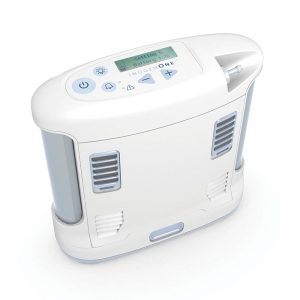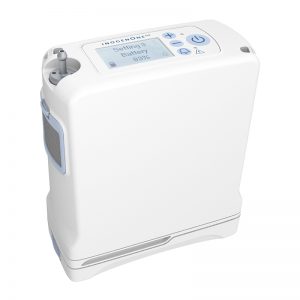-
 In Stock
In StockInogen One G3
Convenient independence - for travel, errands, or visiting family!
- 5 Flow Settings
- 3 Year Warranty
- Up to 4.7 Hours of Use on Single Battery
- Up to 10 Hours of Use on Double Battery
- Convenient Carry Bag
- Meets FAA Requirements (great for travel!)
-
 In Stock
In StockInogen One G4 – Tradeshow Demo
Portable Oxygen Concentrator - for travel, errands, or visiting family! • 3 Flow Settings • 3 Year Warranty • Up to 2.7 Hours of Use on Single Battery • Up to 5 Hours of Use on Double Battery • Protective Covering Bag • Bluetooth Mobile App
Oxygen therapy, also known as “supplemental oxygen” is a medically proven approach to treat conditions related to depleted oxygen levels in the blood. Due to advances in medical technology, patients requiring this treatment no longer need to visit a hospital. They can receive treatment from the comfort of their own home.
Oxygen concentrators are not to be confused with oxygen tanks. For certain conditions, concentrators offer a more effective treatment.
Here, we’re going to take a deeper look at what oxygen concentrators do, how they work, and the conditions they treat. We’ll also review two of the best models on the market today and give some advice on choosing which one is right for you or your loved one.
What is an Oxygen Concentrator?
Oxygen concentrators are machines that extract concentrated oxygen from a supply of gas and deliver it to a patient’s bloodstream via the lungs.
Using a technique called Pressure Swing Absorption, these devices take in regular air from the atmosphere and extract Nitrogen using a molecular sieve. What’s left is a gas that has a much higher level of Oxygen than the air we normally breathe. The gas that is delivered to the patient typically has a concentration rate of 90% – 95%.
This oxygen-rich gas is then passed into the patient either through tubing in the nose or with a regular oxygen mask.
While tubing is less obstructive since it doesn’t cover the patient’s nose and mouth, there are several reasons why a mask may be better under certain conditions:
- Tubing is known to cause dryness inside the nasal passages – something that could be a problem for patients with sinus issues.
- Tubing also cannot be used with the patient has a blocked nose or when the patient is asleep.
In addition, masks also deliver a higher volume of Oxygen per minute than tubing, making them a more ideal way to ingest Oxygen, despite the inconvenience.
Who needs an Oxygen Concentrator?
Oxygen therapy is prescribed to people that suffer from having a low concentration of oxygen in their blood. Some common symptoms are:
- Shortness of breath
- Exhaustion
- Confusion
These symptoms are typically associated with lung disease, cancer, or heart problems.
Understandably, people with these conditions will find these symptoms, so overwhelming that they need constant access to concentrated Oxygen.
For these people, traveling to a hospital to receive treatment isn’t an option. In the past, tanks that contain pressurized gas with a high concentration of Oxygen was the only alternative.
What are the differences between an Oxygen Concentrator and an Oxygen Tank?
Aside from being a more appropriate treatment for certain conditions, there are several other reasons why an Oxygen concentrator is a better investment than traditional Oxygen tanks.
The logistical issues are minimal with concentrators. Gone are the days of having to travel to a medical facility to receive treatment. No longer do patients have to deal with the hassle and expense of having oxygen tanks delivered to their homes, and empty ones carted way.
Tanks are also a major fire hazard. Since Oxygen is highly combustible, a rupture in the tank represents a big risk to the patient and their household. Oxygen concentrators do not store a potentially dangerous volume of the flammable element like tanks do; they generate a small amount that is instantly absorbed by the patient.
Another major benefit of owning a concentrator is that it is much more portable than a hefty oxygen tank. To move a large tank around, equipment is often needed and very few people suffering from serious ailments are able to pick them up.
Oxygen concentrators are also permitted aboard domestic flights in the United States and all foreign flights leaving US soil.
Product Reviews
Inogen is a leader in the industry, and the two devices we review here represent the best balance between quality, affordability, and portability.
Both these devices are both extremely portable and make use of industry-leading technology to enable exceptional oxygen delivery. Crucially, both models are cleared by the FAA for air travel.
Making use of the company’s innovative Intelligent Delivery Technology, these units are able to detect when the patient takes a breath to deliver oxygen in the most efficient way possible. They are also able to detect the depth and rate of a breath cycle, delivering the appropriate amount of Oxygen based on how fast and deep the patient is breathing. Both units have a warranty of three years.
Let’s take a look at the major differences between the two units.
Inogen One G3
Dimensions
Width: 8.75 inches
Depth: 3 inches
Height: 8.25 inches
Weight
4.9 pounds
Number of pulse dose settings
5
Battery life
This varies depending on the battery choice and the pulse dose setting. The maximum life of 9 hours can be achieved with the larger 16-cell battery at a pulse dose setting of 1.
Conversely, on a pulse dose setting of 5, using the smaller 8-cell battery, battery life is limited to 2 hours.
Battery charging time
2 – 4 hours with the smaller 8-cell battery.
Noise level
A pulse dose setting 2: 42 decibels.
Click here to buy the Inogen One G3 now.
Why choose this model?
The primary reason to select the Inogen One G3 is the wider spectrum of pulse dose settings.
Inogen One G4
Dimensions
Width: 5.91 inches
Depth: 2.68 inches
Height: 7.2 inches
Weight
2.8 pounds
Number of pulse dose settings
3
Battery life
Pulse dose setting 1: 2 hours 40 minutes
Pulse dose setting 2: 2 hours 15 minutes
Pulse dose setting 3: 1 hour 20 minutes
Battery charging time
3 hours.
Noise level
A pulse dose setting 2: 40 decibels.
Click here to buy the Inogen One G4 now.
Why choose this model?
The main reason customers choose the G4 over the G3 is its enhanced portability. Not only is it significantly smaller and lighter, but it also runs quietly. Note that this extra flexibility does come at the expense of two extra pulse dose settings, however.
Tips to choose the right Oxygen Concentrator for You
There are plenty of options when it comes to choosing an oxygen concentrator. The market is filled with numerous choices, covering a range of price points and features.
Before you make your purchase, here are some important factors to consider.
NOTE: Prior to making a purchase it is extremely important to obtain the input of the doctor who prescribed the use of the oxygen concentrator. There are factors to consider that involve diagnosis which only a medical professional will be able to provide. Get an opinion by someone that knows you or your loved one’s case personally.
Pulse vs Continuous Flow
One of the most important decisions is whether you want a continuous flow or a pulse flow unit. Continuous flow devices deliver an uninterrupted flow of Oxygen, while pulse models only deliver oxygen when it detects that the patient is inhaling.
The decision on which type to choose comes down to the patient’s medical needs. The general rule of thumb is that if the patient needs 2 – 5 liters of oxygen per minute, a continuous flow concentrator is a right choice.
The major drawback of a continuous flow device is its portability. These units are typically much heavier and require equipment to move around. For patients that do not need such a high volume of oxygen delivered per minute, a pulse dose unit is often a better choice.
Pulse dose concentrators are typically prescribed for patients who need up to 2 liters per minute of Oxygen.
Pulse Dose Settings
Some oxygen concentrators, like the two listed above, offer the ability to configure how the flow of Oxygen is regulated. The more settings that a device has, the wider the spectrum of activities it covers.
Portability
Even pulse dose oxygen concentrators vary in their levels of portability. They come in a very wide range of sizes and weights. Some are even wearable and ship with custom backpacks or shoulder straps.
When establishing that this is the type of unit you need, make sure you find the right balance between specifications and portability.
Be aware that by choosing an extremely portable unit, you will be making compromises in other areas. Be sure to measure all of your needs against the specifications of each unit. This is to make sure you’re not losing out on an important feature just because you prefer the oxygen concentrator to rest on the back.
Battery life
There are many factors that determine how long an oxygen concentrator’s battery lasts and how long it takes to charge fully. Manufacturers are very transparent about this feature of their product.
However, bear in mind that the advertised battery life is typically the amount of time that the unit can operate under ideal conditions. That is to say when it is consuming the least amount of power. Most manufacturers will have more granular information on battery life, based on the unit’s settings. Compare these against your personal needs (as prescribed by your doctor) to ensure that the unit’s battery meets your specific requirements.
Scalability
You don’t want to buy an oxygen concentrator that will need to be replaced within a year. Find out from your doctor how your condition is likely to change over time and purchase a unit that will accommodate any changes in your health needs, be it for the better or worse.
This is one of the main areas where your doctor’s prognosis is essential. Involve the doctor in the decision as much as is possible. No doctor wants to see their patients make a bad investment and most will happily be included in the decision.
Final Thoughts
Obtaining adequate treatment for a condition that has a serious impact on you or a loved one’s lifestyle can be a life-changing experience. For many people struggling with low levels of oxygen in their blood, an investment in an oxygen concentrator is the solution. It gives them new levels of energy and vitality.
If your doctor has prescribed such a device for you, don’t hesitate to delve into the details of what exactly you need, start researching options, and make that life-changing purchase. Check out our top picks for oxygen concentrators today.







